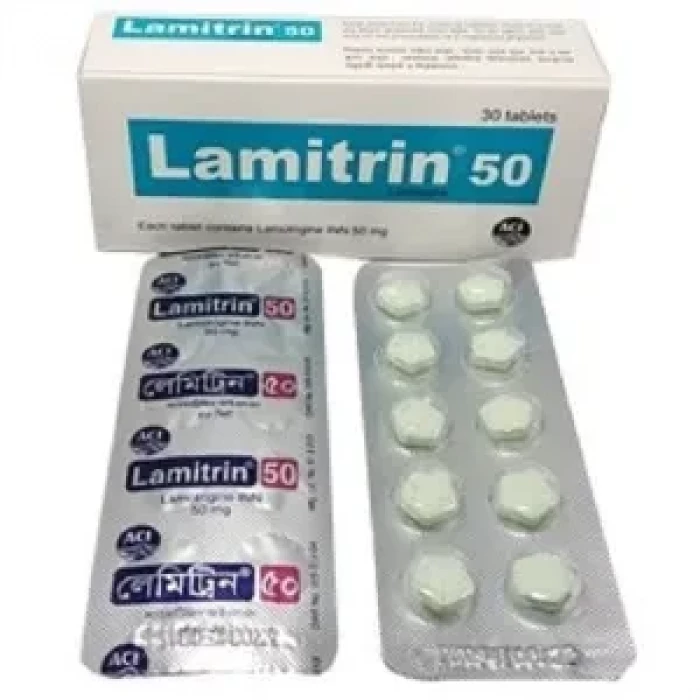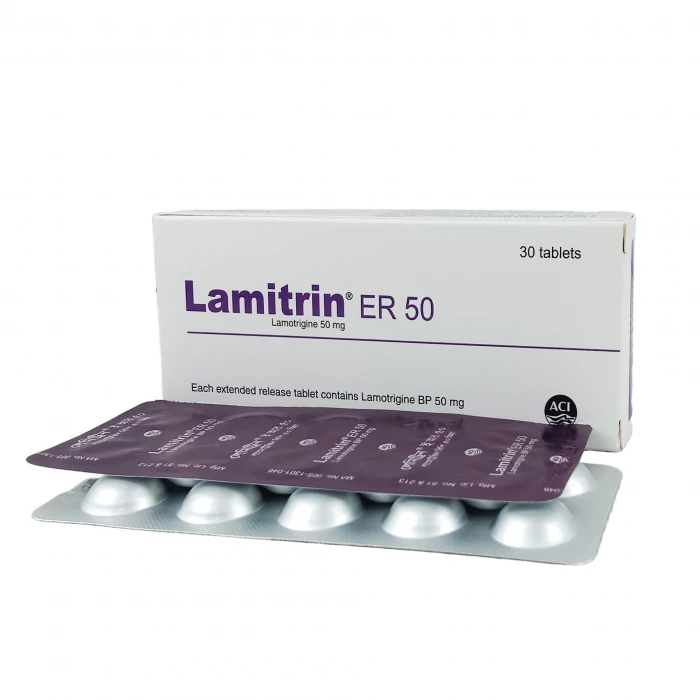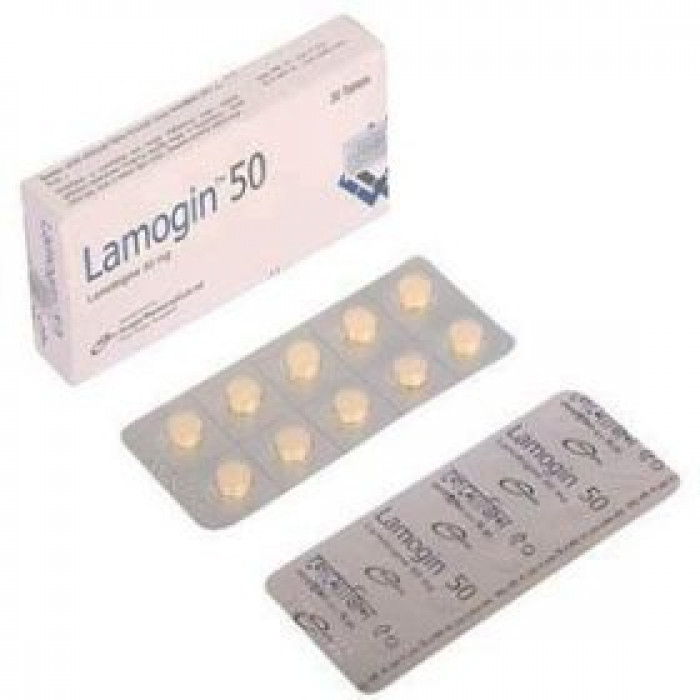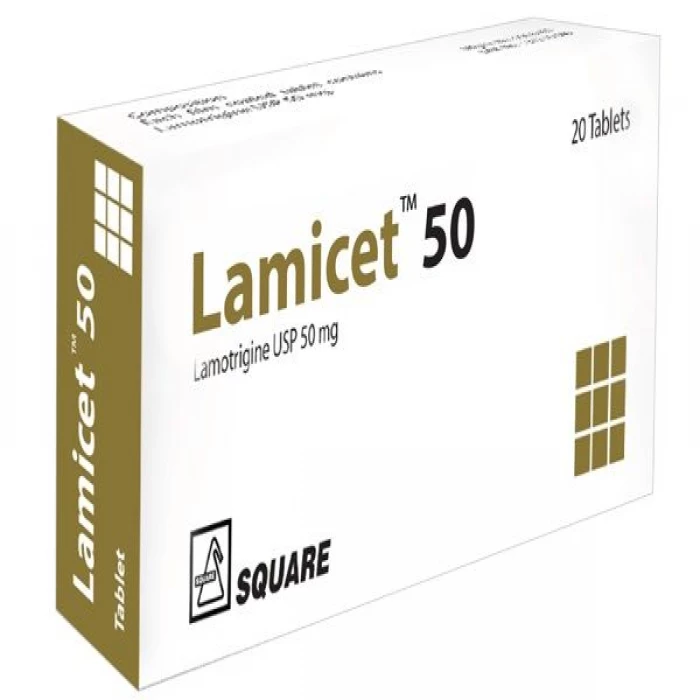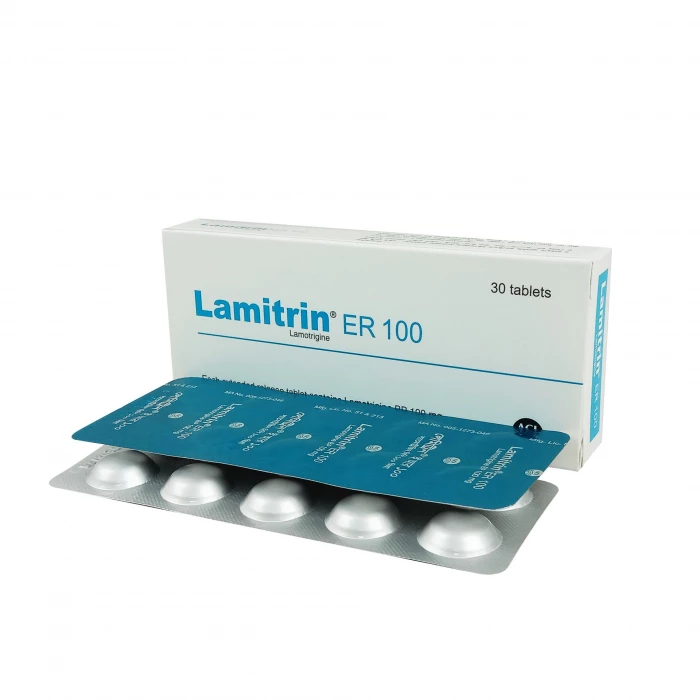
✔ 100% Authentic Product
👁️ Currently Viewing 2000
Lamogin 25mg Tablet 10pcs
Lamogin, a phenothiazine antiepileptic, is used to treat certain types of epilepsy and bipolar disorder. It controls epileptic seizures by inhibiting voltage-sensitive sodium channels, which stabilizes neuronal membranes and consequently reduces the release of presynaptic excitatory neurotransmitters like glutamate and aspartate.
Discount
Price: ৳ 94
MRP:
৳
100
6%
Off

100% Genuine Products, Guaranteed

Safe & Secure Payments, Always

Fast, Secure & Efficient Delivery

Proper Packaging
 Cash on Delivery - All over Bangladesh
Cash on Delivery - All over Bangladesh Regular Delivery - 12-24 Hours, Dhaka City* Charge Tk.39-59
Regular Delivery - 12-24 Hours, Dhaka City* Charge Tk.39-59 Regular Delivery - 24-48 Hours, Other Cities* Charge Tk.99-110
Regular Delivery - 24-48 Hours, Other Cities* Charge Tk.99-110
 ফ্রি ডেলিভারিঃ - ৯৯৯ টাকা+ অর্ডারে, ঢাকা
শহরে
ফ্রি ডেলিভারিঃ - ৯৯৯ টাকা+ অর্ডারে, ঢাকা
শহরে ফ্রি ডেলিভারিঃ - ২৯৯৯ টাকা+ অর্ডারে, ঢাকার
বাহিরে
ফ্রি ডেলিভারিঃ - ২৯৯৯ টাকা+ অর্ডারে, ঢাকার
বাহিরে
100% Genuine Products, Guaranteed
Safe & Secure Payments, Always
Fast, Secure & Efficient Delivery
Proper Packaging
 Cash on Delivery - All over Bangladesh
Cash on Delivery - All over Bangladesh Regular Delivery - 12-24 Hours, Dhaka City* Charge Tk.39-59
Regular Delivery - 12-24 Hours, Dhaka City* Charge Tk.39-59 Regular Delivery - 24-48 Hours, Other Cities* Charge Tk.99-110
Regular Delivery - 24-48 Hours, Other Cities* Charge Tk.99-110 ফ্রি ডেলিভারিঃ - ৯৯৯ টাকা+ অর্ডারে, ঢাকা
শহরে
ফ্রি ডেলিভারিঃ - ৯৯৯ টাকা+ অর্ডারে, ঢাকা
শহরে ফ্রি ডেলিভারিঃ - ২৯৯৯ টাকা+ অর্ডারে, ঢাকার
বাহিরে
ফ্রি ডেলিভারিঃ - ২৯৯৯ টাকা+ অর্ডারে, ঢাকার
বাহিরে
✅ Description:
Lamogin is an antiepileptic drug (AED) indicated for:
Epilepsy:
- Adjunctive therapy (ages 2 and older):
- Partial-onset seizures
- Primary generalized tonic-clonic seizures
- Generalized seizures of Lennox-Gastaut syndrome
- Monotherapy (ages 16 and older)
Bipolar Disorder: For patients aged 18 years and older.
✔️ Pharmacology:
The precise mechanism of action of lamotrigine is not entirely understood, but it likely involves cellular activities contributing to its effectiveness across various conditions. Though chemically distinct, lamotrigine's actions are similar to those of phenytoin and carbamazepine. It inhibits voltage-sensitive sodium channels, stabilizing neuronal membranes and modulating the release of presynaptic excitatory neurotransmitters.
Lamotrigine is believed to inhibit sodium currents by selectively binding to inactive sodium channels, thereby suppressing the release of the excitatory amino acid glutamate. This mechanism is likely consistent across both its anticonvulsant and mood-stabilizing effects. Studies have shown lamotrigine's binding to sodium channels like local anesthetics, which may also explain its benefits in certain neuropathic pain states.
Laboratory binding assays have shown lamotrigine has a weak inhibitory effect on the serotonin 5-HT3 receptor and binds weakly to several other receptors, including adenosine, adrenergic, dopamine, GABA, histamine, opioid, muscarinic, and serotonin receptors. An in vivo study suggested that lamotrigine inhibits Cav2.3 (R-type) calcium currents, potentially contributing to its anticonvulsant properties.
✔️ Overdose Effects:
Overdose can result in ataxia, nystagmus, seizures (including tonic-clonic seizures), decreased consciousness, coma, and intraventricular conduction delay.
✔️ Side Effects:
- Adults: Dizziness, headache, diplopia, ataxia, nausea, blurred vision, somnolence, pharyngitis, and rash.
- Children: Vomiting, diarrhea, infection, fever, abdominal pain, and tremor.
✔️ Dosage & Administration:
Epilepsy:
Table 1: Escalation Regimen for Patients Older Than 12 Years
Weeks 1 & 2:
- No Carbamazepine, Phenytoin, Phenobarbital, Primidone, or Valproate: 25 mg daily
- With Valproate: 25 mg every other day
- With Carbamazepine, Phenytoin, Phenobarbital, or Primidone and no Valproate: 50 mg/day
Weeks 3 & 4:
- No Carbamazepine, Phenytoin, Phenobarbital, Primidone, or Valproate: 50 mg/day
- With Valproate: 25 mg daily
- With Carbamazepine, Phenytoin, Phenobarbital, or Primidone and no Valproate: 100 mg/day (divided doses)
Week 5 onward to maintenance:
- No Carbamazepine, Phenytoin, Phenobarbital, Primidone, or Valproate: Increase by 50 mg/day every 1-2 weeks
- With Valproate: Increase by 25-50 mg/day every 1-2 weeks
- With Carbamazepine, Phenytoin, Phenobarbital, or Primidone and no Valproate: Increase by 100 mg/day every 1-2 weeks
Usual Maintenance Dose:
- No Carbamazepine, Phenytoin, Phenobarbital, Primidone, or Valproate: 225-375 mg/day (divided doses)
- With Valproate: 100-200 mg/day alone; 100-400 mg/day with other glucuronidation-inducing drugs (divided doses)
- With Carbamazepine, Phenytoin, Phenobarbital, or Primidone and no Valproate: 300-500 mg/day (divided doses)
Table 2: Escalation Regimen for Patients Aged 2 to 12 Years
Weeks 1 & 2:
- No Carbamazepine, Phenytoin, Phenobarbital, Primidone, or Valproate: 0.3 mg/kg/day (divided doses)
- With Valproate: 0.15 mg/kg/day (divided doses)
- With Carbamazepine, Phenytoin, Phenobarbital, or Primidone and no Valproate: 0.6 mg/kg/day (divided doses)
Weeks 3 & 4:
- No Carbamazepine, Phenytoin, Phenobarbital, Primidone, or Valproate: 0.6 mg/kg/day (divided doses)
- With Valproate: 0.3 mg/kg/day (divided doses)
- With Carbamazepine, Phenytoin, Phenobarbital, or Primidone and no Valproate: 1.2 mg/kg/day (divided doses)
Week 5 onward to maintenance:
- No Carbamazepine, Phenytoin, Phenobarbital, Primidone, or Valproate: Increase dose every 1-2 weeks to 0.6 mg/kg/day
- With Valproate: Increase dose every 1-2 weeks to 0.3 mg/kg/day
- With Carbamazepine, Phenytoin, Phenobarbital, or Primidone and no Valproate: Increase dose every 1-2 weeks to 1.2 mg/kg/day
Usual Maintenance Dose:
- No Carbamazepine, Phenytoin, Phenobarbital, Primidone, or Valproate: 4.5-7.5 mg/kg/day (max 300 mg/day, divided doses)
- With Valproate: 1-3 mg/kg/day alone; 1-5 mg/kg/day (max 200 mg/day, divided doses)
- With Carbamazepine, Phenytoin, Phenobarbital, or Primidone and no Valproate: 5-15 mg/kg/day (max 400 mg/day, divided doses)
Table 3: Initial Weight-Based Dosing Guide for Patients Aged 2 to 12 Years Taking Valproate (Weeks 1 to 4)
Weeks 1 & 2:
- 6.7-14 kg: 2 mg every other day
- 14.1-27 kg: 2 mg daily
- 27.1-34 kg: 4 mg daily
- 34.1-40 kg: 5 mg daily
Weeks 3 & 4:
- 6.7-14 kg: 2 mg daily
- 14.1-27 kg: 4 mg daily
- 27.1-34 kg: 8 mg daily
- 34.1-40 kg: 10 mg daily
Bipolar Disorder:
Table 4: Escalation Regimen for Adults
Weeks 1 & 2:
- No Carbamazepine, Phenytoin, Phenobarbital, Primidone, or Valproate: 25 mg daily
- With Valproate: 25 mg every other day
- With Carbamazepine, Phenytoin, Phenobarbital, or Primidone and no Valproate: 50 mg daily
Weeks 3 & 4:
- No Carbamazepine, Phenytoin, Phenobarbital, Primidone, or Valproate: 50 mg daily
- With Valproate: 25 mg daily
- With Carbamazepine, Phenytoin, Phenobarbital, or Primidone and no Valproate: 100 mg daily (divided doses)
Week 5:
- No Carbamazepine, Phenytoin, Phenobarbital, Primidone, or Valproate: 100 mg daily
- With Valproate: 50 mg daily
- With Carbamazepine, Phenytoin, Phenobarbital, or Primidone and no Valproate: 200 mg daily (divided doses)
Week 6:
- No Carbamazepine, Phenytoin, Phenobarbital, Primidone, or Valproate: 200 mg daily
- With Valproate: 100 mg daily
- With Carbamazepine, Phenytoin, Phenobarbital, or Primidone and no Valproate: 300 mg daily (divided doses)
Week 7:
- No Carbamazepine, Phenytoin, Phenobarbital, Primidone, or Valproate: 200 mg daily
- With Valproate: 100 mg daily
- With Carbamazepine, Phenytoin, Phenobarbital, or Primidone and no Valproate: up to 400 mg daily (divided doses)
✔️ Use in Special Populations:
- Pediatric Use:
- Epilepsy: Safety and effectiveness for adjunctive treatment in patients aged 1 to 24 months not demonstrated.
- Bipolar Disorder: Safety and effectiveness for maintenance treatment not established in patients aged 10 to 17 years.
✔️ Interactions:
- Valproate increases Lamogin concentrations more than two-fold.
- Carbamazepine, phenytoin, phenobarbital, primidone, and rifampin decrease Lamogin concentrations by about 40%.
- Estrogen-containing oral contraceptives reduce Lamogin concentrations by about 50%.
- Protease inhibitors lopinavir/ritonavir and atazanavir/ritonavir decrease Lamogin exposure by approximately 50% and 32%, respectively.
✔️ Pregnancy & Lactation:
- Pregnancy Category C: Lamotrigine is excreted in human milk. Due to potentially serious adverse reactions in nursing infants, decide whether to discontinue nursing or the drug, considering its importance to the mother.
✔️ Precautions & Warnings:
- Discontinue at the first sign of a rash.
- Monitor for blood dyscrasias (e.g., neutropenia, thrombocytopenia, pancytopenia).
- Monitor for suicidal thoughts or behaviors.
- Monitor for signs of aseptic meningitis.
✔️ Storage Conditions:
Store in a dry place, below 25°C, protected from light, and out of reach of children.
⚠️Disclaimer:
At ePharma, we’re committed to providing accurate and accessible health information. However, all content is intended for informational purposes only and should not replace medical advice from a qualified physician. Please consult your healthcare provider for personalized guidance. We aim to support, not substitute, the doctor-patient relationship.




